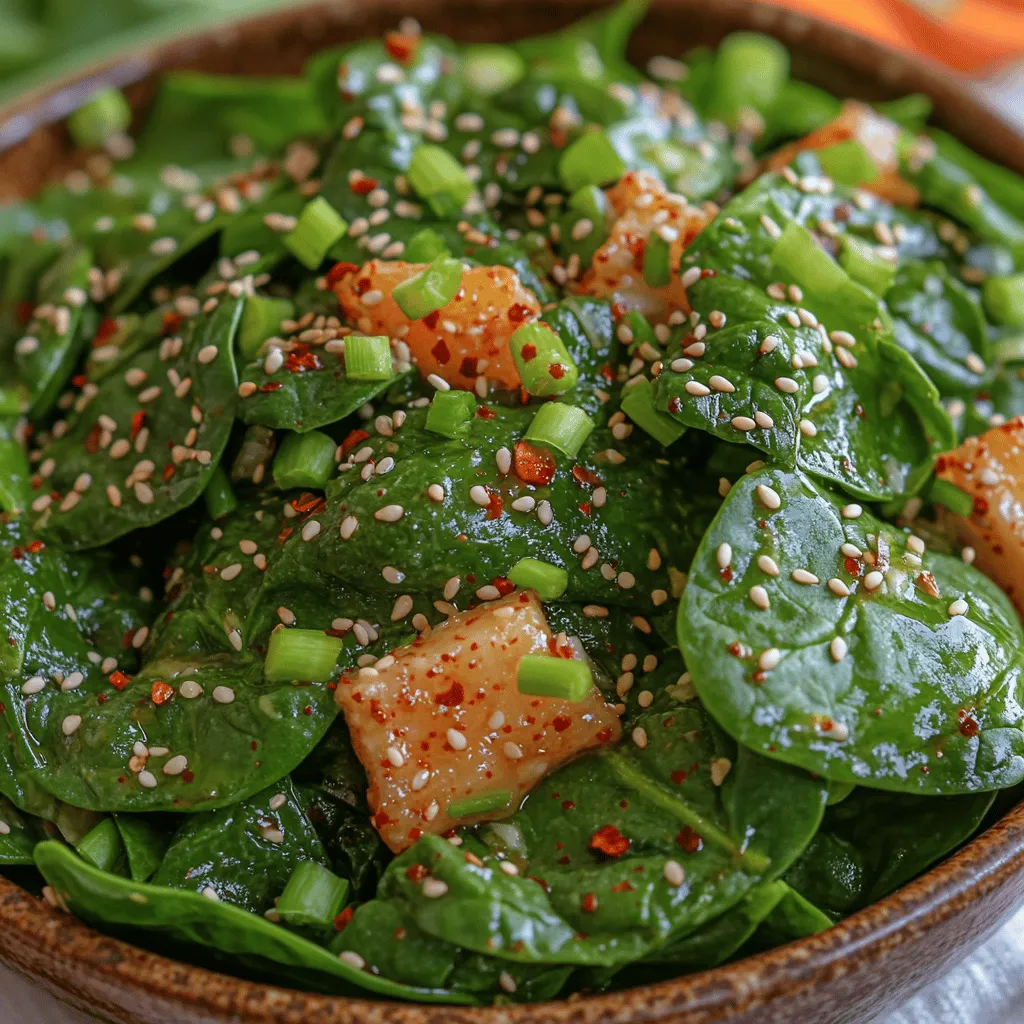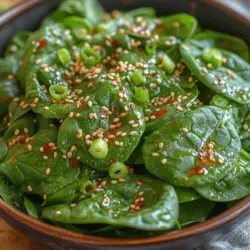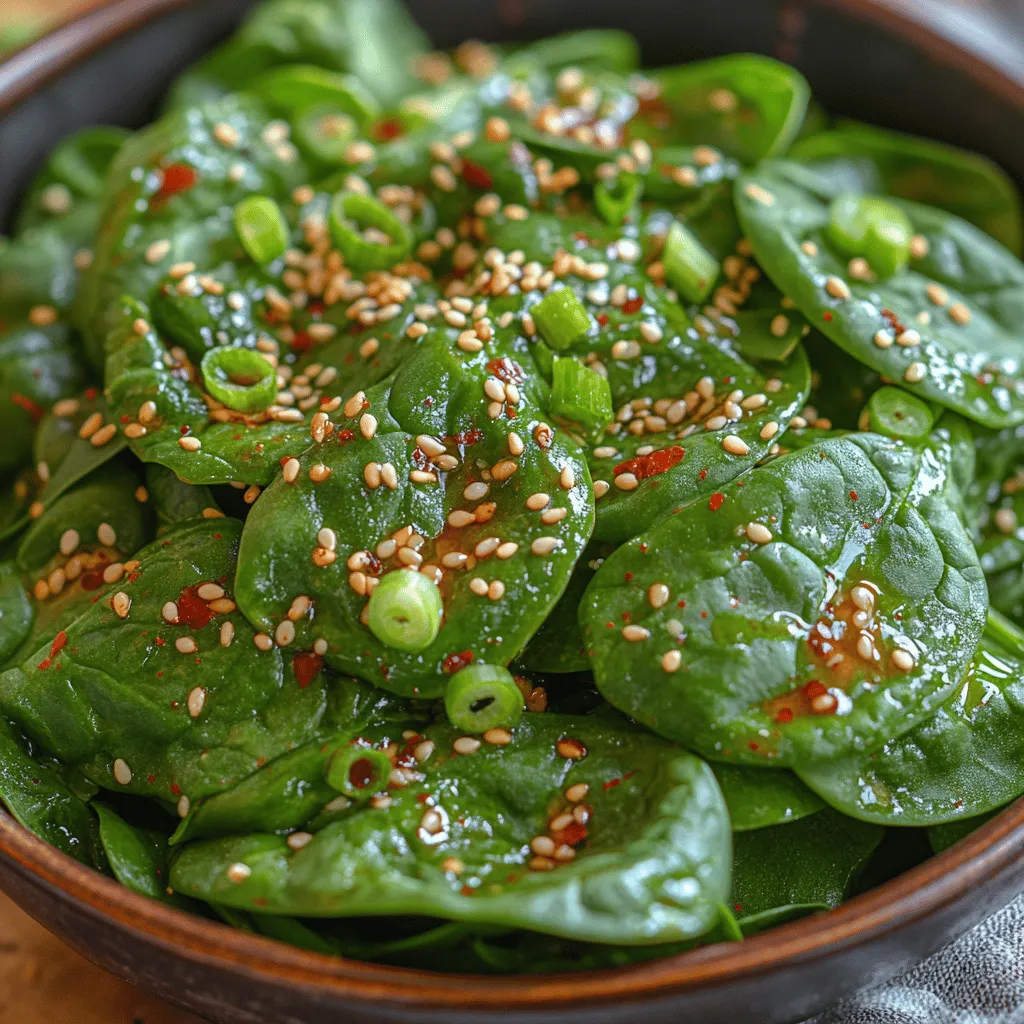Introduction
Korean cuisine is celebrated for its vibrant flavors, fresh ingredients, and healthful dishes. At the heart of this culinary tradition lies a commitment to using seasonal produce, which brings a delightful variety of textures and tastes to the table. One such dish that embodies this philosophy is the Fresh & Flavorful Korean Spinach Salad, known as “Sigeumchi Namul.” This salad is more than just a side dish; it represents a harmonious balance of taste and nutrition, making it a beloved staple in Korean households.
Spinach plays a pivotal role in this dish, showcasing its versatility and nutritional benefits. Rich in vitamins A, C, and K, along with essential minerals like iron and calcium, spinach is a powerhouse of health benefits. It not only adds a vibrant green hue to the salad but also contributes to its nourishing qualities. The combination of fresh spinach with a light, flavorful dressing creates a refreshing dish that complements various Korean meals, from grilled meats to hearty stews.
In this article, we will explore the rich history of spinach in Korean cuisine, delve into the nutritional advantages of this leafy green, and provide a detailed breakdown of the ingredients that make up this delightful salad. We will also guide you through the step-by-step process of preparing this dish, allowing you to embrace the fusion of tradition and modernity in your cooking.
Understanding Spinach in Korean Cuisine
Spinach has a long-standing significance in Korean diets, dating back centuries. It is often associated with the health-conscious approach of traditional Korean cooking, where fresh vegetables were considered essential for maintaining overall well-being. Historically, spinach has been cultivated in Korea since the Goryeo Dynasty, and over time, it has become a staple ingredient in various dishes, including soups, stews, and side dishes.
The nutritional benefits of spinach are widely recognized across cultures, but its prominence in Korean cuisine is particularly noteworthy. Spinach is an excellent source of vitamins and minerals, including vitamin K, which is crucial for bone health, and vitamin A, which supports vision and immune function. Additionally, spinach contains antioxidants that help combat oxidative stress and inflammation in the body.
When compared to spinach preparation methods in other cultures, Korean cuisine often emphasizes simple yet flavorful techniques. In contrast to Western salads that may feature raw spinach with heavy dressings, Korean spinach dishes typically involve blanching the leaves briefly to enhance their color and tenderness while preserving their nutritional integrity. This method allows the spinach to retain a vibrant green hue and a fresh taste, making it an ideal base for a light salad.
Ingredients Breakdown
To create the Fresh & Flavorful Korean Spinach Salad, you will need the following ingredients, each playing a crucial role in the overall flavor profile and texture of the dish:
Fresh Spinach
As the star ingredient, fresh spinach provides not only a burst of color but also a multitude of health benefits. When selecting spinach, opt for vibrant, crisp leaves that show no signs of wilting or discoloration. The freshness of the spinach will significantly impact the salad’s taste and texture, ensuring that each bite is crisp and refreshing.
Garlic
Garlic is a quintessential ingredient in Korean cuisine, known for its ability to add depth and complexity to dishes. In this salad, minced garlic not only enhances the flavor but also offers numerous health benefits, including anti-inflammatory properties and immune support. Its pungent aroma and taste elevate the overall profile of the salad, creating a delightful contrast with the fresh spinach.
Sesame Oil
Sesame oil is a staple in Korean cooking, revered for its rich, nutty flavor. It serves as the base for the dressing in this salad, imparting a distinct taste that complements the spinach beautifully. Beyond its flavor, sesame oil is also known for its health benefits, including high levels of antioxidants and heart-healthy fats. A small amount goes a long way, enriching the salad without overpowering the other ingredients.
Soy Sauce
Adding umami to the dish, soy sauce is another essential ingredient in Korean cuisine. It brings a savory depth to the dressing, balancing the freshness of the spinach with its rich, salty flavor. Soy sauce also contains various nutrients, including protein and antioxidants, making it a valuable addition to your salad.
Rice Vinegar
Rice vinegar contributes acidity and balance to the dressing, cutting through the richness of sesame oil and soy sauce. Its mild flavor enhances the overall taste without overwhelming the fresh ingredients, making it an ideal choice for a salad dressing. Additionally, rice vinegar is often used in Korean pickling processes, highlighting its cultural significance.
Sugar and Salt
Sugar and salt are crucial for enhancing and balancing the flavors in the salad. A touch of sugar helps to mellow the acidity of the vinegar and the saltiness of the soy sauce, creating a harmonious dressing that elevates the taste of the spinach. Salt, on the other hand, is essential for seasoning the dish and bringing out the natural flavors of the ingredients.
Sesame Seeds and Green Onion
For added texture and visual appeal, toasted sesame seeds and chopped green onions are sprinkled over the salad. Sesame seeds provide a delightful crunch and a nutty flavor, while green onions add freshness and a mild oniony taste. Together, they enhance the salad’s presentation and create a multi-dimensional eating experience.
Red Pepper Flakes (Optional)
For those who enjoy a bit of heat, red pepper flakes can be added to the dressing. This optional ingredient introduces a spicy kick that is characteristic of many Korean dishes, allowing you to customize the salad to your taste preferences. The heat from the red pepper flakes complements the other flavors, adding an exciting twist to the dish.
Step-by-Step Instructions
Blanching the Spinach
The first step in preparing the Fresh & Flavorful Korean Spinach Salad is blanching the spinach. This process not only helps preserve the vibrant green color of the leaves but also enhances their tenderness and flavor. Here’s how to do it:
1. Prepare the Spinach: Start by washing the fresh spinach thoroughly under cold running water to remove any dirt or grit. Once cleaned, shake off excess water and remove any tough stems.
2. Boil Water: In a large pot, bring a generous amount of water to a rolling boil. Adding salt to the water can help season the spinach and enhance its flavor during the blanching process.
3. Blanch the Spinach: Once the water is boiling, carefully add the spinach to the pot. Let it cook for about 30 seconds to 1 minute, just until the leaves are wilted and bright green. Be careful not to overcook the spinach, as you want to maintain its vibrant color and nutritional value.
4. Shock in Ice Water: After blanching, quickly transfer the spinach to a bowl of ice water. This technique, known as shocking, stops the cooking process and helps preserve the spinach’s bright color. Allow the spinach to sit in the ice water for a few minutes before draining.
5. Drain and Squeeze: Once the spinach is cool, drain it well and gently squeeze out any excess moisture. This step is crucial, as excess water can dilute the dressing and affect the overall texture of the salad.
By following these initial steps, you will prepare the spinach perfectly for the salad, setting the stage for a delightful and healthy dish that showcases the essence of Korean cuisine. In the next sections, we will explore how to create the dressing and assemble the salad, bringing together all the flavors and textures for a truly satisfying culinary experience.

Importance of Blanching and Its Impact on Texture and Color
Blanching is a crucial step in preparing Korean spinach salad, enhancing both the texture and color of the spinach. This cooking technique involves briefly boiling the spinach and then shocking it in ice water to halt the cooking process. The result is vibrant green leaves that maintain their crispness and nutritional value. Blanching not only brightens the spinach but also softens its fibers, making it easier to digest while preserving its fresh taste.
Tips for Perfect Blanching
To achieve perfect blanching, follow these essential tips:
1. Use Plenty of Water: Fill a large pot with water and bring it to a rolling boil. The water should be enough to allow the spinach to move freely, ensuring even cooking.
2. Salt the Water: Adding salt not only enhances the flavor but also helps to maintain the spinach’s bright green color. A general rule of thumb is to use about a tablespoon of salt per quart of water.
3. Timing is Key: Blanch the spinach for only 30 seconds to 1 minute. Overcooking can lead to a loss of nutrients and a mushy texture. The goal is to wilt the leaves without losing their vibrant color.
4. Ice Bath: Immediately transfer the spinach to a bowl of ice water after blanching to stop the cooking process. This method preserves the spinach’s crispness and bright color.
5. Drain Thoroughly: After cooling the spinach in the ice bath, drain it well and gently squeeze out excess moisture. This helps maintain the right texture for your salad.
Preparing the Dressing: Achieving the Right Balance of Flavors
The dressing is what truly elevates the Korean spinach salad, providing a burst of flavor that complements the freshness of the spinach. The classic dressing typically consists of soy sauce, sesame oil, garlic, and vinegar, which together create a savory, nutty, and slightly tangy flavor profile.
How to Achieve the Right Balance of Flavors
1. Soy Sauce: Use low-sodium soy sauce for a healthier option. The soy sauce acts as the base for the dressing, bringing umami flavor.
2. Sesame Oil: This oil adds a rich, nutty flavor. Use toasted sesame oil for a more intense taste, but be mindful of the quantity, as it can overpower other flavors.
3. Vinegar: Rice vinegar is the preferred choice, providing a mild acidity that balances the saltiness of the soy sauce. Adjust the amount to your taste; start with one tablespoon and increase if desired.
4. Garlic: Freshly minced garlic adds depth to the dressing. You can also experiment with adding ginger for an extra kick.
5. Sweetness: If you prefer a sweeter dressing, consider adding a teaspoon of sugar or honey. This can balance the saltiness and acidity, making for a more rounded flavor.
Importance of Whisking and Mixing Methods
When mixing the dressing, whisking is essential to achieve a smooth and cohesive texture. Use a small bowl and a whisk or fork to combine all the ingredients thoroughly. If you prefer, you can also place the ingredients in a jar with a tight lid and shake vigorously. This method ensures that the flavors meld together beautifully.
Combining Ingredients: Gentle Tossing Techniques
Once your spinach is blanched and drained, and the dressing is prepared, it’s time to combine the ingredients. The key here is to be gentle to maintain the integrity of the spinach leaves.
1. Use a Large Bowl: Transfer the blanched spinach to a spacious bowl. This allows ample room for tossing without crushing the leaves.
2. Drizzle the Dressing: Pour the dressing over the spinach, ensuring even coverage. Start with a smaller amount, as you can always add more if needed.
3. Toss Gently: Using your hands or a pair of tongs, gently toss the spinach with the dressing. The goal is to coat the leaves without tearing them. Be patient and take your time during this step.
Options for Customization
This salad is versatile, allowing for various customization options:
– Add Proteins: For a heartier dish, consider adding proteins such as grilled chicken, tofu, or shrimp. These additions can transform the salad into a satisfying meal.
– Incorporate Other Vegetables: You can enhance the salad by adding thinly sliced cucumbers, radishes, or carrots for extra crunch and flavor.
– Nuts and Seeds: Toasted sesame seeds or chopped nuts can add a delightful crunch and nutty flavor, complementing the salad beautifully.
Serving Suggestions
Presentation plays a significant role in the enjoyment of any dish, and this Korean spinach salad is no exception.
Presentation Ideas
1. Colorful Plating: Serve the salad in a white bowl to let the vibrant green spinach and colorful toppings stand out. You can also layer it with other colorful ingredients to create visual interest.
2. Garnish: Top with sesame seeds, thinly sliced green onions, or even edible flowers for an elegant touch.
Pairing with Traditional Korean Dishes
This salad pairs beautifully with a variety of traditional Korean dishes. Consider serving it alongside:
– Bulgogi: The marinated and grilled beef provides a savory contrast to the fresh salad.
– Kimchi: The spicy and fermented flavors of kimchi complement the mildness of the spinach salad, offering a well-rounded meal.
Serving as a Light Meal or Side Dish
The Korean spinach salad can be enjoyed in various contexts:
– As a Light Meal: Add proteins and serve it as a standalone meal, particularly during warmer months when lighter fare is preferred.
– As a Side Dish: It makes an excellent side dish for grilled meats or rice dishes, adding freshness and balance to a richer meal.
Cultural Significance and Variations
Korean spinach salad holds a special place in the culinary landscape of Korea, often served as a banchan (side dish) during meals.
How This Salad Fits into Broader Korean Meals
In Korean culture, meals are typically composed of multiple side dishes, and salads like this one provide balance and contrast to richer flavors. The salad’s fresh ingredients and light dressing make it an ideal accompaniment to heavier dishes.
Regional Variations
Across different regions of Korea, variations of this salad may include additional ingredients such as sesame leaves, perilla, or varying types of vinegar. Each region brings its own twist, often influenced by local produce and culinary traditions.
Modern Adaptations
As Korean cuisine has gained international popularity, this spinach salad has evolved. Chefs and home cooks alike have begun incorporating global ingredients while maintaining the essence of the original dish. You may find versions that include ingredients like quinoa, avocado, or even citrus dressings, catering to diverse palates while celebrating the salad’s fresh flavors.
Health Benefits of the Ingredients
This Korean spinach salad is not only delicious but also packed with health benefits:
In-Depth Look at Health Benefits
1. Spinach: Rich in vitamins A, C, and K, spinach is a powerhouse of nutrients. It promotes healthy skin, aids in eye health, and supports bone health.
2. Garlic: Known for its immune-boosting properties, garlic is also linked to heart health and may help reduce blood pressure.
3. Sesame Oil: This oil contains healthy fats and antioxidants, contributing to heart health and providing anti-inflammatory benefits.
4. Soy Sauce: While high in sodium, using low-sodium options can provide the umami flavor without excessive salt intake.
Supporting a Balanced Diet
The combination of fresh vegetables, healthy fats, and flavor-packed dressing makes this salad a great addition to a balanced diet. It’s low in calories while being rich in nutrients, making it a fantastic choice for those looking to maintain a healthy lifestyle.
Nutritional Analysis
Compared to common Western salads, this Korean spinach salad stands out for its nutrient density. While many Western salads rely on creamy dressings and cheese, this salad focuses on fresh ingredients, making it lower in calories but high in vitamins and minerals.
Conclusion
The Korean spinach salad is a celebration of freshness, flavor, and health. Its simple yet vibrant ingredients come together to create a dish that not only pleases the palate but also nourishes the body. As you explore this traditional recipe, you’ll find that it embodies the essence of Korean cuisine—balanced, wholesome, and full of life.
Incorporating recipes like this one into modern diets is essential for connecting with our culinary roots while embracing healthier eating habits. So, whether you’re serving it as a side dish alongside your favorite Korean barbecue or enjoying it as a light meal on its own, this salad offers an inviting taste of Korea that everyone can enjoy. Take the plunge into Korean cuisine, and savor the simplicity and adaptability of this refreshing salad.

